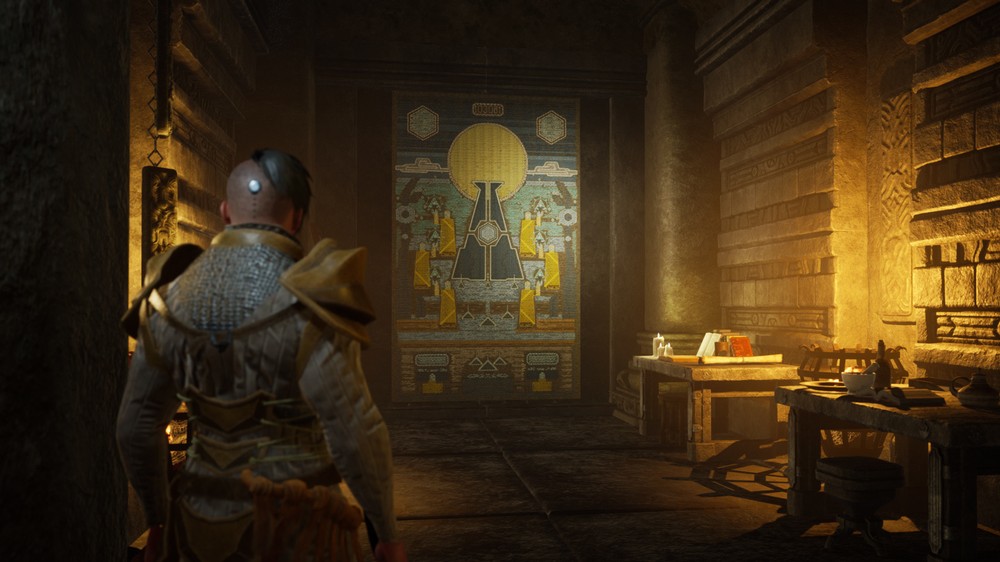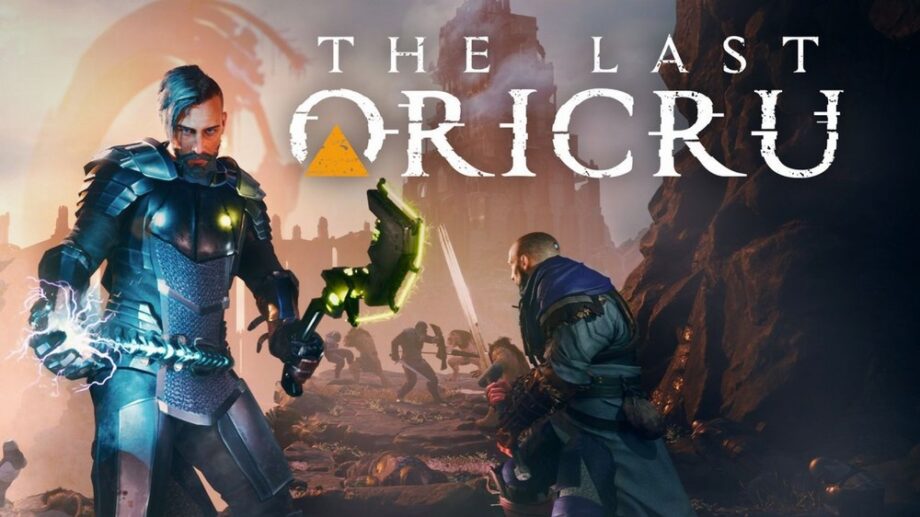The Last Oricru is the first project to come out of the Prague-based studio Goldknights and the team is comprised of about 40-headcount between Europe and the US. The team aimed high for a 3rd-person, action-adventure game that has a choice-based story and soul-like level design. This is their first game and the studio aims to release an epic adventure that has a flexible, self-selecting narrative design. It’s a tall order from a small team for their first project and while the game has solid design, the execution leaves much to be desired.
You start your adventure by being gutted to death, receiving a mysterious message from a floating head, and then waking up in an alien medieval world. It’s jarring to say the least. A mysterious high-tech belt grants your regeneration, but no explanations. The mysterious message from an AI who knows more than you do sets you on your way to uncover your high-tech origins of humanity in a Middle Ages, alien world you now occupy. Think the Witcher, if it was on an alien planet and you were stepping out of an Arther C. Clarke novel. While playing through the tutorial, I compared notes with my co-reviewer’s experience and decisions and found that we each went about playing through the opening chapters very differently. It was fun to compare notes and see just how differently a single decision we made gave us different outcomes. This is where the frustrations begin.
 The gameplay wants to be deeper than it is. While the game has no shortage of enemy types, weapons, armor, and stat sheets, I found that brute forcing a strength-build in order to brute force my way through the story. While there’s plenty of enemy types, they all kinda feel like the same enemy. While there are bosses to shake up the formula, it’s clear the game borrowed the level design of the Dark Souls franchise, not unlike a multitude of other titles. Winding your way through Byzantine corridors to find your next tech hub (bonfire) is only fun if the combat feels fair. In this iteration of the familiar design, the combat feels a mile wide but an inch deep. Most of the weapons feel the same, most of the enemies feel the same, most of the times dying when you hit the dodge button feels all too familiar. Nevertheless, you press on to the next hub and save-state. At these weigh stations you can hop into another player’s game instance, level up your equipment, and increase the stats of your character. I quickly found that my leveling strategies were to fully unlock the requirements for all the equipment I was picking up.
The gameplay wants to be deeper than it is. While the game has no shortage of enemy types, weapons, armor, and stat sheets, I found that brute forcing a strength-build in order to brute force my way through the story. While there’s plenty of enemy types, they all kinda feel like the same enemy. While there are bosses to shake up the formula, it’s clear the game borrowed the level design of the Dark Souls franchise, not unlike a multitude of other titles. Winding your way through Byzantine corridors to find your next tech hub (bonfire) is only fun if the combat feels fair. In this iteration of the familiar design, the combat feels a mile wide but an inch deep. Most of the weapons feel the same, most of the enemies feel the same, most of the times dying when you hit the dodge button feels all too familiar. Nevertheless, you press on to the next hub and save-state. At these weigh stations you can hop into another player’s game instance, level up your equipment, and increase the stats of your character. I quickly found that my leveling strategies were to fully unlock the requirements for all the equipment I was picking up.
 The story is interesting enough, as you try to uncover your origin and untangle the power struggle happening around you. Each side character is distinct and memorable. With each decision, you’ll raise the affinity of different characters’ opinions of you or political party. This will determine whether certain parties attack you or not. The main conflict is between large rat-like creatures called Ratkins and their oppressive overlords, the Naboru. The Naboru are a highly authoritarian structure all vying for the royal seat of power while trying to squash the rebellious Ratkin race. There’s a third type called The Broken Army, but they’re not a major people group. The story is written anachronistically tung-in-cheek and even breaks the fourth wall at times. Sometimes it feels as if the writer wants to make sure you know how much they liked the Witcher, even directly quoting lines from the game/book.
The story is interesting enough, as you try to uncover your origin and untangle the power struggle happening around you. Each side character is distinct and memorable. With each decision, you’ll raise the affinity of different characters’ opinions of you or political party. This will determine whether certain parties attack you or not. The main conflict is between large rat-like creatures called Ratkins and their oppressive overlords, the Naboru. The Naboru are a highly authoritarian structure all vying for the royal seat of power while trying to squash the rebellious Ratkin race. There’s a third type called The Broken Army, but they’re not a major people group. The story is written anachronistically tung-in-cheek and even breaks the fourth wall at times. Sometimes it feels as if the writer wants to make sure you know how much they liked the Witcher, even directly quoting lines from the game/book.
The redeeming factor of my play-through was how often I was able to betray people. I thought it was hilarious how terrible a human my character was. I would promise loyalty one second, only to kill my ally the second someone offered me a better deal. It’s hard to build a narrative structure around how malevolent and selfish I was. Unfortunately, that’s where the fun stops.
 The Last Oricru has bugs and a lot of them. Characters will strike t-poses, you’ll drop through the floor of the world, and the camera will float aimlessly during dialogue scenes. Not to mention the hit detection on some of the attacks and dodges is awful. All these issues were said to be resolved according to the documentation provided by the publisher, and I ran into every single one, multiple times playing post-launch. Furthermore, I deleted the game and downloaded the latest version’s chapter one and still ran into issues. So, for now, I’d say “buyer-beware”. None of them was game-breaking but it did produce a death by thousand cuts when I was starting to have fun.
The Last Oricru has bugs and a lot of them. Characters will strike t-poses, you’ll drop through the floor of the world, and the camera will float aimlessly during dialogue scenes. Not to mention the hit detection on some of the attacks and dodges is awful. All these issues were said to be resolved according to the documentation provided by the publisher, and I ran into every single one, multiple times playing post-launch. Furthermore, I deleted the game and downloaded the latest version’s chapter one and still ran into issues. So, for now, I’d say “buyer-beware”. None of them was game-breaking but it did produce a death by thousand cuts when I was starting to have fun.
The bugs continue into the online co-op mode. My partner would glitch and teleport around the screen. While we were able to play though the level together, it was incredibly distracting having one character pop in and out of existence 10 times a second. The best thing I can say about the online co-op is that it functions.
 The game takes about 15 hours if you’re playing some of the side content along with the main quests. The most notable feature of this game is the online co-op within a souls-like game. It’s fun to play a souls-like formula side-by-side, but the quality control undercuts any lasting impact. I found the bulk of my time pushing through to the next story beat so I could make a new decision and see how flexible the game’s branching story was. I was happy to backstab and flip-flop from accomplice to assassin, few games are flexible enough to handle this level of skullduggery.
The game takes about 15 hours if you’re playing some of the side content along with the main quests. The most notable feature of this game is the online co-op within a souls-like game. It’s fun to play a souls-like formula side-by-side, but the quality control undercuts any lasting impact. I found the bulk of my time pushing through to the next story beat so I could make a new decision and see how flexible the game’s branching story was. I was happy to backstab and flip-flop from accomplice to assassin, few games are flexible enough to handle this level of skullduggery.
The fun that The Last Oricru has to offer is buried under an excessive tutorial, unresolved bugs, and cringy dialogue. It’s not an awful game, but it’s just not worth the time or money. The idea is solid, but the minute-to-minute gameplay isn’t fun. It’s a commendable effort to undertake such a complicated and broad game, but it should have been polished and refined to make the combat feel fair and fun. Sadly, this is one epic adventure you’re better off not having.











